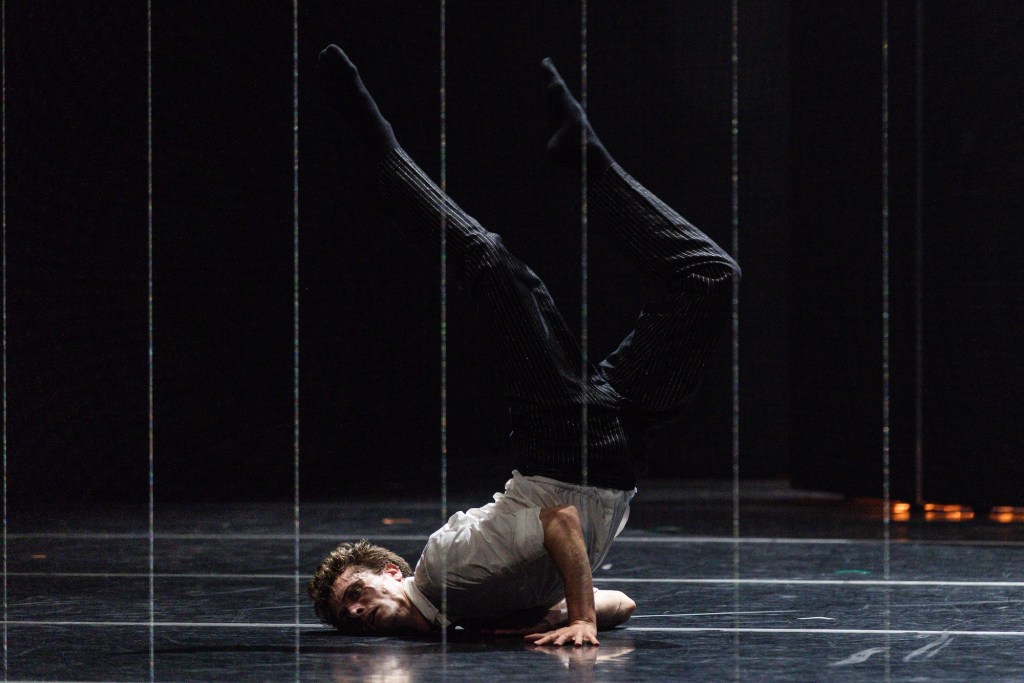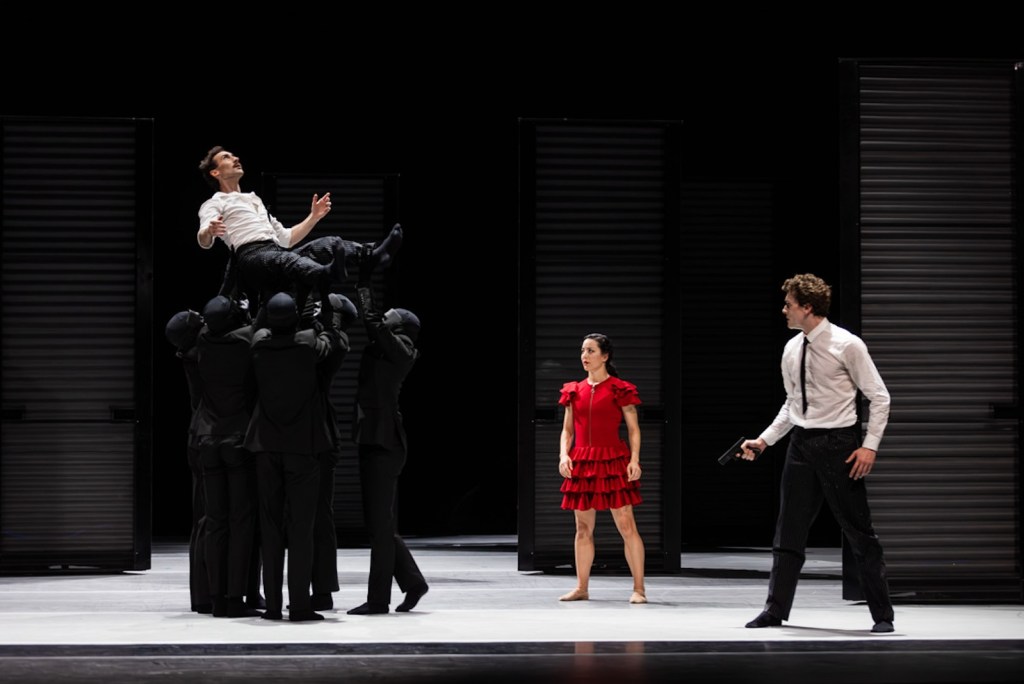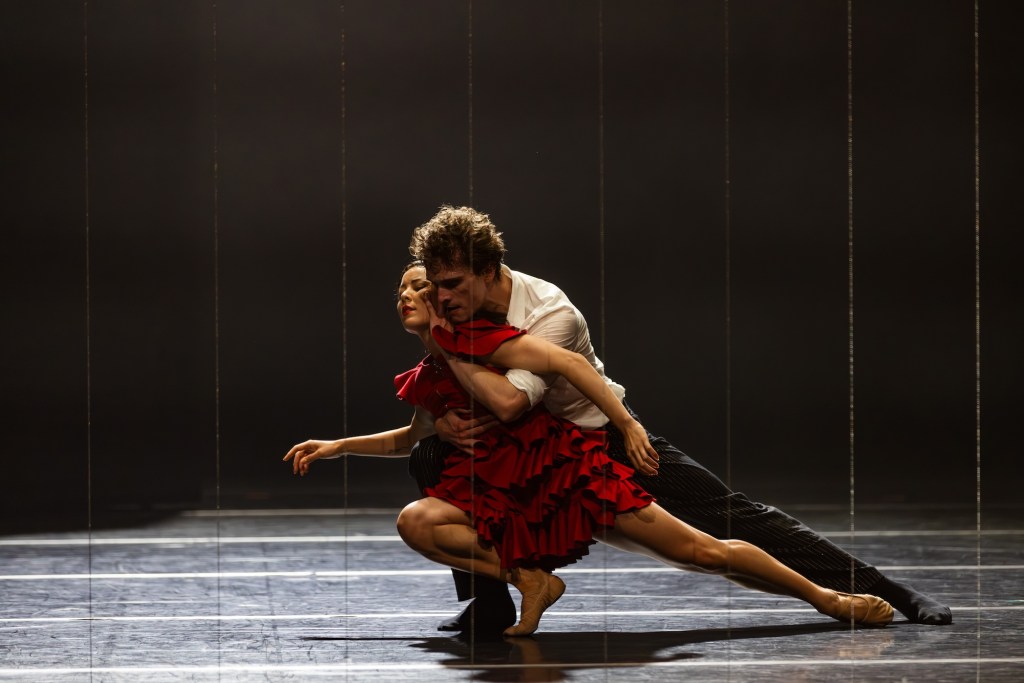The curtain rises to a largely vacant stage with dim lighting. A lone, childlike figure – Boy (Lilla Harvey) – appears with a ball. Then, almost as a spirit from a dark underworld, a black faceless figure starts to interact with the youth – taunting and haunting.
It is not what one would expect as the opening scenes for Carmen – made famous by George Bizet’s 19th century opera about a feisty, ruffle-clad cigarette factory worker-cum-seductress, complete with mantillas and castanets. But there’s no sunny Spain in The Australian Ballet’s production.
But then, nothing is “expected” with Swedish choreographer Johan Inger’s 2015 award-winning production of Carmen.
Inger takes his cue, rather, from Prosper Mérimée’s original 1845 novella, which dwells more on the ‘ugly manifestations of machismo’, and translates that as contemporary violence to women, often witnessed through the eyes of a young child.
While many will find the leap challenging, and bleak, it is a refreshing rethink of repertoire and relevancy in our times. It is bold, it is ambitious – and, I would venture to add, brilliant.
It is being performed in a Sydney exclusive, and a repertoire first for The Australian Ballet. However, it is not the first work by Inger performed by the company; audiences got a taste of his unique language in 2022 with I New Then.
Where Carmen is interesting is that it reflects upon Don José’s (Callum Linnane) psychological state and unhinging, more so than the feisty liaisons of Carmen (Jill Ogai). Conquests become something entirely other – more psychological and less sexual.
Sure, we have plenty of those steamy duos on stage, but they feel more driven by a wielding of power and agency – both male and female. Carmen in this role, uses her sexuality as a tool, and while confined by male power, she does not cower to it.
Jill Ogai is mind-blowingly fantastic as Carmen, and pulls off that complexity and range of emotions. She is all grit. She is expressive and lithe as a dancer – those back bends! – and uses her body with such incredible command. Her performance is meticulous.
Equally, the audience is witness to Don José’s emotions becoming increasingly unhinged – an emotion that seemingly pours out of Linnane’s every gesture, extension and rotation. His role is fiercely athletic, and yet he remains fluid in his tall stature, flicking between those elegant long lines and a kind of unpredictable, frayed rupture, sending muscles on edge.

The guards, Dogs and Cigarreras complete that picture. The women are suitably salacious and lively, and the audience feels a rush of energy as they arrive onstage. They’re all limbs and squats, deep pliés and lots of floor work – appealing to the audience. A great moment is the bitchy fight between Manuela (Larissa Kiyoto-Ward) and Carmen.
Emotions such as these are given great range through Rodion Shchedrin’s brilliant arrangement of Bizet’s recognisable score, while music additions by Marc Álvarez drive that tone of melancholy and tension with percussive elements. I like that it unshackles us from our expectations, and is superbly in sync with Inger’s choreography. Conductor Daniel Capps hit it in its delivery.
The set (Curt Allen Wilmer and Leticia Gañán with Estudio DeDos) is stripped right back – again feeding into this holistic tension. The players work with nine large, movable forms that are turned to reveal louvres and mirrors. They are corralled to frame the action, which is perhaps best played out in Toreo (Marcus Morelli) who dances to a bank of mirrors in his sequinned bolero – the perfect expression of his narcissism.
Seeing we are talking about staging, a nod needs to be paid to the costumes by the late Spanish fashion designer David Delfín. Yes, there’s the hint of a frill for the Cigarreras, and a bit of Toreador bling for Morelli – but the women feel more disengaged in their sexuality, similar to Robert Palmer’s cloned severity with tight chignons and make-up, than your shabby buxom factory worker.
At one moment they slip their dresses down to their waists and, in another, Carmen steps entirely out of hers. It portrays a contrived sexuality rather than sensuality – Inger’s bodily gestures navigating this complexity, moving between classical and contemporary moves.
In the second act, Delfín’s costumes reframe the Cigarreras and the Dogs, swapping their frills for black-masked, ninja-like body suits, as they roll across the stage at great speed – a metaphor for mounting inner turmoil.
Earlier in the first act, they scoop up Carmen’s lover, the head guard Zúñiga (Brett Chynoweth) when he is shot by Don José, which reads as a kind of stop-frame animation of a crime scene cut-out in fluid motion. Again, they are not expected devices for Carmen, but they are clever storytelling, and open the production to a range of fresh choreography.

This surreal and haunting foundation is also played out in two vignettes. When Don José and Carmen dance their last tragic dance, leading to Carmen’s death, they twirl almost a veneer of a dream lost, playacting. Similarly, in an earlier brief scene, Carmen, Don José and the Boy play “happy families”, only to be snapped back into a darker reality.
Inger delivers all the clues for us to stitch together.
Violence happens. Reality bites. Carmen is dead. She falls away from Don José, out of her dress, leaving it in his hands. We are left with an image of him slumped in a corner of the stage, completely depleted of life or meaning himself. There is no mistaking its currency today.
Bodily gesture, emotion and staging find incredible synergy in this production by Inger, and are conveyed by The Australian Ballet soloists and corps, who are able to work with his choreography to bring depth to this narrative in our times. It is hard to find fault.
Carmen
The Australian Ballet
Sydney Opera House
10-27 April
Lighting Design: Tom Visser
Set Design: Curt Allen Wilmer and Leticia Gañán with Estudio DeDos
Costume Design: David Delfín
Johan Inger’s Carmen was first performed by Compañia Nacional de Danza in Madrid, and won the 2016 Benois de la Danse Award.





